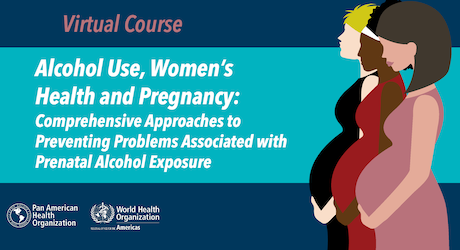
Washington DC, 25 June 2019 (PAHO) – The rates of alcohol disorders among women are higher in the Region of the Americas than in any other region of the world. A new virtual course from the Pan American Health Organization (PAHO) will provide health care workers with the technical skills they need to identify and address alcohol consumption in pregnant women and those of reproductive age.
Alcohol use in pregnancy presents a significant risk for both pregnant women and their fetus, leading to a number of negative outcomes such as miscarriage, low birth weight and preterm birth, and can lead to fetal alcohol spectrum disorders, which are irreversible
The course, “Women’s health and pregnancy: holistic approaches to preventing problems relating to prenatal exposure to alcohol”, now available in Spanish, provides health workers with the latest, evidence-based information on health promotion strategies for pregnancy; the early detection of alcohol use in pregnancy; and how to support women to reduce alcohol use.
“Alcohol use in pregnancy presents a significant risk for both pregnant women and their fetus, leading to a number of negative outcomes such as miscarriage, low birth weight and preterm birth, and can lead to fetal alcohol spectrum disorders, which are irreversible” said Dr. Maristela Monteiro, Senior Advisor on Alcohol and Substance Abuse at PAHO. “It is vital that health care workers have access to the latest research in order to implement appropriate interventions before women become pregnant, as this will ensure the best outcomes for mother and child,” she added.
While men have historically been the bigger consumers of alcohol and suffer from more alcohol-induced consequences, women are increasingly drinking larger amounts of alcohol and more often. Most women are unaware of their status in the first months of pregnancy, and may continue to drink, unknowingly putting their unborn child at risk.
This is particularly significant in the Americas, where 3.2% of women aged 15 years and older are estimated to have an alcohol use disorder, which is two and a half times the global average of 1.3%. This puts them at increased risk of a number of other health problems, including breast cancer, heart disease and stroke. It is more difficult to reduce or stop drinking when a disorder already exists, and even more difficult during pregnancy.
Alcohol and pregnancy
Alcohol use is a clear risk factor for adverse pregnancy outcomes including stillbirth, miscarriage, premature birth, intrauterine growth impairement, and low birth weight. Globally, the prevalence of alcohol use in pregnancy among the general population is 9.8%. In the Americas, this figure is 11.2%.
Consuming alcohol during pregnancy, even in small amounts can cause the unborn child to develop fetal alcohol spectrum disorder (FASD). FASD includes mental disorders such as learning disabilities, intellectual disabilities, and speech and language delays, and physical disorders, including abnormal facial features, vision and hearing problems, and heart, kidney or bone conditions. These disorders affect people during their entire lifetime. FASD is infrequently diagnosed in most countries of the Region so health professionals need to become more aware of these conditions, so that early detection results in the necessary health, education and social services being made available to affected individuals.
Online course
The online course is now available in Spanish and should take around eight hours to complete.
It has been designed for health professionals, including nurses, psychologists, doctors, and community health workers, as well as others who work in primary health care, maternal health and mental health.
The course consists of seven modules: alcohol use and women’s health; alcohol consumption and pregnant women’s health; the impact of alcohol consumption in pregnancy on the fetus and the newborn; family relationships; identifying alcohol use during pregnancy; short interventions and treatment; and health implementation and promotion.




